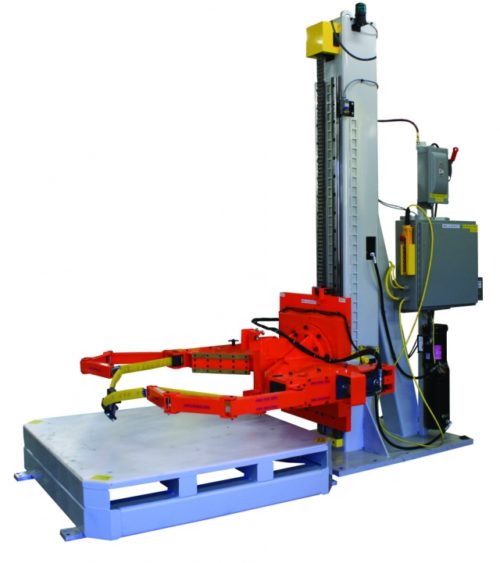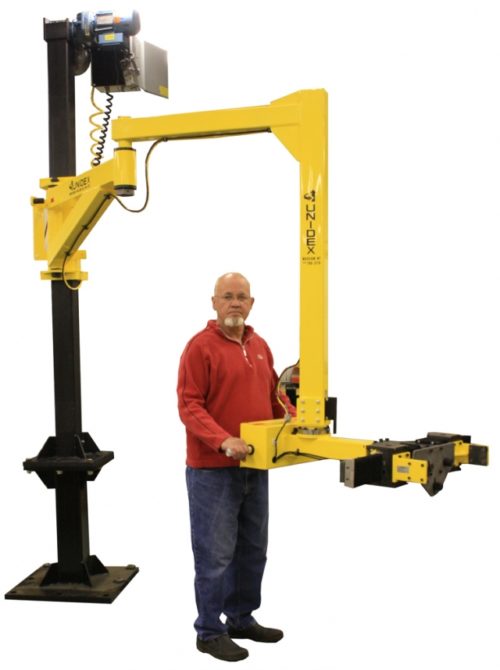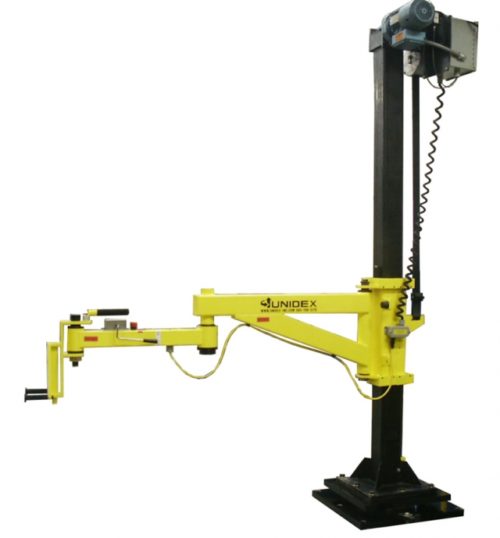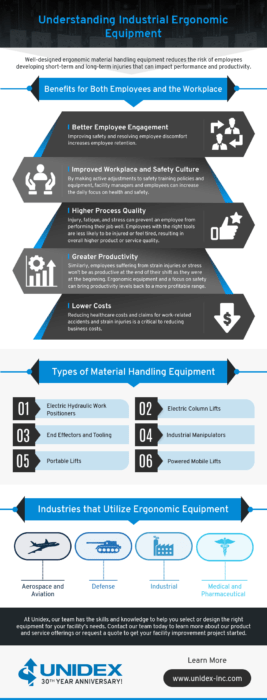Why Industrial Ergonomics Matters
Implementing industrial ergonomics ensures your employees have access to the best tools and working techniques for a given work environment. By designing the right work processes and choosing the right tools, employers can create a safer and more comfortable workspace that reduces the risk of injuries and allows employees to be more productive.
 Some examples of industrial ergonomic equipment include electric lifting columns and electric hydraulic positioners. These tools lift and position equipment and materials so that employees don’t have to lift or readjust large or heavy items manually. They also have designs that allow for smooth control and a variety of different movements that minimize the amount of motion-related strain experienced by operators throughout their shift.
Some examples of industrial ergonomic equipment include electric lifting columns and electric hydraulic positioners. These tools lift and position equipment and materials so that employees don’t have to lift or readjust large or heavy items manually. They also have designs that allow for smooth control and a variety of different movements that minimize the amount of motion-related strain experienced by operators throughout their shift.
Focusing on ergonomics allows business owners and managers to keep their employees safer and happier and reduce their operational costs due to the lower risk of injuries and related health costs. Overall, it leads to better efficiency and productivity, resulting in significant savings costs and profit increases.
At Unidex, our team has the skills and knowledge to help you achieve this goal. With three decades of experience providing high-quality material handling equipment, we can help you select the best equipment for your facility and industry to support ergonomic design.
Ergonomics in the Workplace
Worksite design is one of the most important factors in improving employee health, satisfaction, and productivity. Approximately one-third of the money paid out in workers’ compensation claims is for musculoskeletal disorders, many of which are partially or entirely caused by workplace strain and injury. Considering industrial ergonomics in facility design can help reduce this percentage.
Why Is Ergonomics Important?
Ergonomic principles emphasize the importance of designing equipment and your facility’s layout according to the limitations of the human body. As a simple example, placing commonly used items near the floor or overhead requires employees to bend down or climb a step ladder multiple times throughout the day, which drastically increases the risk of injury. Placing the items at elbow height puts less strain on the body and reduces the risk of falling or being crushed. Similarly, choosing ergonomically designed equipment with easy-to-use controls and significant lifting power is better than using poorly designed equipment or manual tools like hand trucks.
The nature of a work task also contributes to the risk of employee injury. For example, the following types of tasks can place excessive strain on an employee:
- Highly repetitive tasks
- Heavy load carrying and handling tasks
- Tasks requiring repetitive or sustained awkward poses
Recently, regulatory bodies have placed more focus on workplace safety issues caused by poor design or ergonomics. Organizations such as the Washington State Department of Labor and Industries (L&I) and the National Institute for Occupational Safety and Health (NIOSH) have developed measurement tools for the ergonomic quality of workplaces and tasks. These tools allow for better assessment of a workplace and facilitate the implementation of proper protections for workers.
Impact of Ergonomic Equipment
Ergonomic equipment can significantly reduce the development of musculoskeletal disorders in workers. Teams with access to such equipment no longer have to exert high levels of force or maintain awkward positions and postures for long periods. Training courses on proper body mechanics can also help employees recognize and respond to joint strain or muscle pain faster.
Benefits of Ergonomics in Industrial Facilities
Introducing more ergonomic equipment into the workplace has several benefits for both workers and the company. Here are five key benefits:
- Better employee engagement: Improving safety and resolving employee discomfort increases employee retention. Workers are much more likely to continue working with a company that actively makes improvements regarding comfort and safety.
- Improved workplace and safety culture: By making active adjustments to safety training policies and equipment, facility managers and employees can increase the daily focus on health and safety. This, in turn, makes employees safer and more aware of how to stay safe on the job.
- Higher process quality: Injury, fatigue, and stress can prevent an employee from performing their job well. Employees with the right tools are less likely to be injured or feel stressed and tired, resulting in overall higher product or service quality.
- Greater productivity: Similarly, employees suffering from strain injuries or stress won’t be as productive at the end of their shift as they were at the beginning. This can become a long-term factor that negatively impacts employee productivity. Ergonomic equipment and a focus on safety can bring productivity levels back to a more profitable range.
- Lower costs: Reducing healthcare costs and claims for work-related accidents and strain injuries is critical to reducing business costs. Injuries can cause expenses such as direct payouts, lower periods of productivity, and the potential costs of hiring and training new employees.
- Industry reputation: Implementing ergonomics into your operation is not only ethical, it’s also good for business. Ergonomic practices and equipment rank among the best practices used by most major manufacturers. OEMs and other tier one suppliers prioritize partnerships with responsible manufacturers who take steps to improve the safety and wellbeing of others.
Examples of Ergonomic Equipment
Well-designed ergonomic material handling equipment reduces the risk of employees developing short-term and long-term injuries that can impact performance and productivity. Two examples of such ergonomic equipment include:
Electric Hydraulic Work Positioners
EH positioners can elevate, tilt, rotate, and position heavy and bulky items for employees. Their motion controls allow for precise and straightforward movements in areas with tight positional tolerance. Employees can use these tools during assembly and production lines to minimize the amount of manual force or sustained awkward positioning required.

Electric Column Lifts
Electric column lifts provide vertical movement control for bulky or heavy items. They have articulated arms for smooth control, and the arms can be different lengths to best suit the work environment.
Operators can use this electrically powered lifting device to lift and adjust goods for placement on warehouse shelves or to hold parts in place during assembly. The controls allow for easy height adjustment and powered rotations. Employees can then reach in or under the lifted items without having to worry about the weight of the item. The finely tuned positioning also allows workers to adjust the height for a more comfortable working environment.
Applications of Ergonomic Equipment
Every industry can benefit from employing ergonomic equipment in the workplace. At Unidex, we are proud to serve the following industries with our ergonomic material handling equipment:
Aerospace and Aviation
In the aerospace and aviation industry, countless hours of research and design have been committed to improving the safety or comfort of people who work in or use aircrafts. Some of the aircraft components focused on include seats and storage spaces. Ergonomic lifting tools such as column lifts can help during precision repairs or assembly tasks along the plane exterior.
Defense
Military and defense facilities need well-designed lifting tools that can help service members and employees maintain inventory without risking injuries. Defense applications for material handling equipment include loading and offloading materials and equipment between storage areas and workspaces.
Industrial
In general industrial settings, workers need to be able to lift and move heavy or bulky goods. ECL systems allow workers to position items for finishing work and assembly. Workers can also use hydraulic manipulators to lift heavy items for storage or inspection.
Medical and Pharmaceutical
In the medical industry, ergonomic principles are employed in a variety of applications, such as in the positioning and responsiveness of touch controls and the placement of screens and overhead scanning equipment. Column lifts help doctors, nurses, and technicians position heavy medical equipment near patients. Pharmaceutical facilities also use heavy-duty ergonomically designed equipment to handle heavy equipment or finished products.
30 Years of Material Handling Expertise
 At Unidex, we help facilities consider their workplace’s current design and make improvements that increase employee safety, productivity, and well-being. For 30 years, our company has provided global access to intuitive, highly precise equipment that gives operators the ability to lift and move heavy items easily. We offer a broad selection of material handling products to help our customers optimize their facilities, including:
At Unidex, we help facilities consider their workplace’s current design and make improvements that increase employee safety, productivity, and well-being. For 30 years, our company has provided global access to intuitive, highly precise equipment that gives operators the ability to lift and move heavy items easily. We offer a broad selection of material handling products to help our customers optimize their facilities, including:
- End effectors and tooling: Our team can create products with custom manual, mechanical, and powered end effectors. Every tool can be modified to match your facility’s needs.
- Industrial manipulators: We manufacture a wide selection of industrial manipulators, including overhead manipulators, column lifts with horizontal positioning arms, and jib arms.
- Portable lifts: Our portable lifts include tables, workstations, and trucks for moving heavy tanks and cylinders.
- Powered mobile lifts: Our powered lifts come in a variety of load capacities and can be built with additional shaft handling or telescoping parts.
- Work positioners: We carry a wide range of work positioners that can handle heavy loads and position them within tight tolerances for inspection and finishing work.
In addition to our standard ergonomic products, we offer full modification and engineered-to-order capabilities to ensure you receive a material handling product that meets your exact specifications.
Consult With the Unidex Team
Ergonomic equipment reduces the risk of workplace injuries and the development of musculoskeletal disorders. The right equipment can lift, carry, and position objects, so employees don’t have to take on the physical strain.
At Unidex, we’ve created and supplied ergonomic equipment for three decades. Our expert team has the skills and knowledge to help you select or design the right equipment for your facility’s needs.
Contact our team today to learn more about our product and service offerings or request a quote to get your facility improvement project started.


